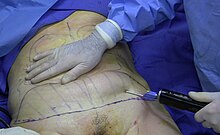Abdominal etching

Abdominal etching, or Ab etching, is a plastic surgery procedure invented by plastic surgeon Henry A. Mentz, III in the early 1990s that uses a special cannula to contour and shape abdominal fat pad to provide patients with a flatter stomach. The procedure selectively removes a small amount of fat around the patient's natural muscular contours and shapes or sculpts the abdomen to create a more athletic contour.[1]
Prior to the procedure, the surgeon makes detailed markings of the patient's flexed ab muscles and uses the markings to remove fat and highlight the patient's individual muscular structure. The procedure is suitable for patients who are already in shape and who have between one to two centimeters of "pinchable belly fat". It is not suitable for patients with larger accumulations of abdominal fat seeking to significantly reduce their belly size or accomplish weight reductions as the amount of fat removed is fairly small. A traditional liposuction is more suitable for those patients.[2]
References
- ^ "USDA Government Journal Reference"
- ^ Jacob Goldstein, "Six-pack surgery: From puffy to buff", Wall Street Journal, October 30, 2007
